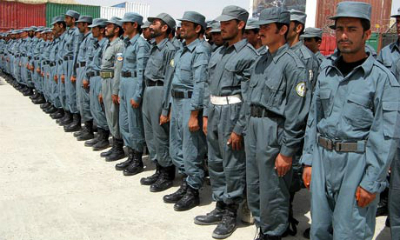By Jamie Tarabay
Shortly after the U.S.-led military invasion of Afghanistan in 2001, the international community, together with the transitional Afghan government, set about standing up security forces to counter retreating Taliban forces and remaining Al-Qaeda fighters. Along with the Afghan National Army, in 2002 it established the Afghan National Police (ANP), which consisted of uniformed police, border police, anti-crime officers and civil order police.
Since then it has spent over $3.6 billion dollars on police salaries and payroll costs, with U.S. taxpayers paying $1.3 billion of that tally. The U.S. will continue to spend $300 million annually on ANP salaries while U.S. forces reduce their presence on the ground. It’s part of the ongoing U.S. commitment to Afghanistan’s security.
But those payments will continue without any guarantees the money is going where it’s supposed to, a new report by the Special Inspector General for Afghanistan Reconstruction [SIGAR] has found.
After nine years focusing on building a payroll system that works, SIGAR says the two main electronic systems used for payroll data are not fully functional and cannot even communicate with each other.
“There is no documentation that unit commanders are accurately reporting subordinate personnel attendance,” SIGAR noted. “All these factors could result in personnel being paid for days not worked, either with or without the knowledge of supervisory personnel.”
Identification cards, meant to be the bridge between the two systems, are incorrect or not being used on a daily basis to record officer attendance. Additionally, there are almost twice as many ANP ID cards in circulation as there are active police officers, SIGAR says. Police officers who leave the force are not made to hand in their ID cards. The failure to collect the ID cards exposes the ANP to corruption as well as security threats, the watchdog said. Further, there are dozens of police officers who have yet to receive their ID cards.
Nearly 20 percent of the ANP were at risk of not getting their full salaries because they are paid in cash by agents appointed by the Afghan Interior Ministry. There is limited oversight of these agents, SIGAR says, and risk of corruption. The international military force command says that corruption by these agents “could take as much as 50 [percent] of a policeman’s salary.”
None of the three authorities — the Combined Security Transition Command for Afghanistan (CSTC-A), the Afghan Interior Ministry (MOI), or the United Nations Development Program (UNDP) — have verified the payroll processes. Consequently, there are no accurate numbers of how many police officers there are and whether they are the same people receiving the U.S. money. “UNDP’s independent monitoring agent may have artificially inflated the percentage of successfully verified ANP personnel from 59 percent to as much as 84 percent,” SIGAR noted.
“Unless the MOI develops the capability to ensure and verify the accuracy of ANP personnel and payroll data, there is a significant risk that a large portion of the more than $300 million in annual U.S. government funding for ANP salaries will be wasted or abused,” SIGAR said.

Afghan police officers who were trained by the British soldiers of NATO's International Security Assistance Force (ISAF) stand during a graduation ceremony in Helmand, Afghanistan, 4 August 2010. (Photo: Stringer/EPA)E
The ANP’s payroll data system was established in 2005, and by July of last year was working in 25 of Afghanistan’s 34 provinces. However, the remaining nine provincial headquarters handle just over half of all ANP personnel, and cannot enter data directly into the system because they have little or no Internet access. Those provinces have to physically transport that data on compact discs, SIGAR reported.
The system also lacks the ability to properly identify recruits, often entering them at higher ranks, which allows them to receive salary and entitlement benefits “at this inflated level for the remainder of his or her ANP service,” the report found.
As international forces draw down, the U.S. government will become completely reliant on the Afghan government and its security forces to ensure the data is accurate and the money is being paid correctly. SIGAR recommended improved oversight and mandatory controls be implemented quickly. “The window of opportunity to effect change is narrowing and this may be the international community’s last chance to ensure that ANP data collection and reporting processes lead to accurate salary payments,” SIGAR said.
The U.S. military acknowledged the shortfalls.
In a handwritten note, Maj. Gen. Todd Semonite responded that the U.S. military would be increasing fiscal oversight and discipline and wouldn’t release the funds otherwise. “It is CSTC-A’s intent to not transfer DOD (Department of Defense) funds for 2015 to UNDP until we can be assured of revised process control by UNDP,” Semonite wrote. “There is no doubt that we still have more to accomplish, but in the last 90 days we have applied significant rigor. We look forward to your review of our strategy.”
As the U.S. commitment in Afghanistan continues, SIGAR’s role investigating taxpayer-funded projects will persist. It has recently catalogued a number of programs that may have squandered money. U.S. government agencies recently were unable to specify successes in programs designed to aid Afghan women. Another report discovered that Afghan troops had an oversupply of weapons and trouble tracking their shipments.
SIGAR also inspected a $3 million food-storage facility that has never been used, along with a faltering $34 million initiative to develop a market for soybeans, which are not traditionally farmed or eaten by Afghans.



